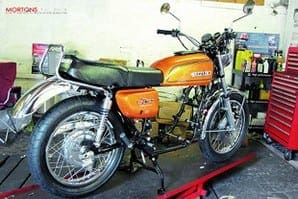
Step-by-step images and captions are available in the image gallery.
View Suzuki GT750: part one
View Suzuki GT750: part three
View Suzuki GT750: part four
Picture one: First I'm going to finish mounting the forks, then I can get the wheels fitted. Like many Japanese bikes of the period, the GT750 has its headlamp mounted to the forks by means of two chromed brackets which slide over the stanchions, and are then sandwiched between the two yokes. As the left-hand bracket was accident damaged, owner Roy has opted to fit a new pair. The yokes have rubber cups both above and below them, and chromed steel shrouds which cover the bottom yoke. On this bike I've added taper roller head bearings, so the yokes will be further apart than standard; so I've had to fit an extra O-ring around each leg to secure the headlamp brackets.
 Picture two: With both brackets and all the mounting rubbers in place the top yoke can go on. A little waggling is required to get it all to fit, but once it’s engaged with the steering stem and both stanchions I can fit the top stem nut and wind it down to seat the yoke. At this stage I'll adjust the head bearings, then finally loosen each fork leg pinch bolt in the bottom yoke and position the top of the stanchion level with the top yoke before nipping up all the pinch bolts. Note the rubber bushes for the clock mountings.
Picture two: With both brackets and all the mounting rubbers in place the top yoke can go on. A little waggling is required to get it all to fit, but once it’s engaged with the steering stem and both stanchions I can fit the top stem nut and wind it down to seat the yoke. At this stage I'll adjust the head bearings, then finally loosen each fork leg pinch bolt in the bottom yoke and position the top of the stanchion level with the top yoke before nipping up all the pinch bolts. Note the rubber bushes for the clock mountings.
Picture three: Slotting in the front wheel is easy now, with just a little attention to the pictures I took at the stripdown to make sure the spacers and speedo drive gearbox are all in the right position. The wheel spindle can be bolted up into the wheel first before the whole assembly fits into the fork legs and is secured by these two clamps. Note the lovely shiny new disc.
Picture four: I've already assembled the clocks onto their new mounting bracket, now I only need to drop in the two mounting bolts and tighten them up to fit the whole caboodle to the top yoke. The correct mounting bolts are shouldered, so when tightened fully they leave some movement in the rubber bushes to isolate the clock from vibration.
 Picture five: I've already rebuilt the calipers with new pistons and seals, so now I can drop them over the new discs and bolt them up. And of course, it's at precisely this point that I realise the old Kettle should have its calipers in front of the fork legs, not behind them, so it's backtrack a few steps to swap the fork legs around. D’oh. The powder coating on the caliper bodies not only looks good, it should be a lot more durable than the original painted finish.
Picture five: I've already rebuilt the calipers with new pistons and seals, so now I can drop them over the new discs and bolt them up. And of course, it's at precisely this point that I realise the old Kettle should have its calipers in front of the fork legs, not behind them, so it's backtrack a few steps to swap the fork legs around. D’oh. The powder coating on the caliper bodies not only looks good, it should be a lot more durable than the original painted finish.
Picture six: By modern standards the front brake plumbing on the Kettle is hideously complex, and it takes me a while to sort through the parts list to figure out exactly what should go where. The hose unions pass through a rubber bushing on each side, and each rubber bush is held to the fork leg with a pressed steel bracket. For some reason I've ended up with some duplicate parts here, which complicates the issue somewhat, but that's because I've had all the original bits replated and Roy has supplied me with new replacements too. I've sorted through them all to make sure the best parts get fitted to the bike.
Picture seven: It's a bit premature really, but at the back end I'm now bolting on the chainguard. There's a couple of reasons I like to assemble parts which are handy, rather than wait until I need them; firstly it reduces the pile of bits in boxes, leaving less clutter to sort through when looking for something specific. Secondly it gives me advance warning if something is missing, or for some reason doesn't fit as it should. And it temporarily makes the bike look a bit more complete, which is good for morale!
 Picture eight: And good morale is what's required when a setback presents itself. Temporarily refitting the freshly painted fuel tank, I now discover that the bottom yoke pinch bolts are going to clout the tank on full lock. For some reason the lockstops allow the steering to rotate a few degrees too far. This is a mystery, as I didn't notice anything untoward when I examined the original bike, but everything is correctly fitted and the problem won't go away, so some kind of a solution is required.
Picture eight: And good morale is what's required when a setback presents itself. Temporarily refitting the freshly painted fuel tank, I now discover that the bottom yoke pinch bolts are going to clout the tank on full lock. For some reason the lockstops allow the steering to rotate a few degrees too far. This is a mystery, as I didn't notice anything untoward when I examined the original bike, but everything is correctly fitted and the problem won't go away, so some kind of a solution is required.
Picture nine: After making a lot of phone calls, and asking anyone who may have any insight into the problem, I'm getting no further. Time is marching on and I need to keep the project moving, so a radical solution is required. Stripping down the front end after some very careful measuring, I take the top yoke round to Richard Williams Engineering and get the lockstops built up with weld, then take it back to Triple S for powder coating again. That works, but it's an odd one and I'd be interested to find out why it was necessary. The best, and most likely explanation I've come up with so far, is that the bike has been crashed in the past and repaired with a different bottom yoke, possibly from a GT550.
Picture 10: That's it for the rolling chassis for now, time to take a look at the motor. The top of the crankcase had a chunk broken out of it by the generator cover mounting, so I've used a plastic metal compound to build it up before dressing it off with a hand file. Alloy welding would have been better, but would have taken more time and money, and would never have looked as neat. As the surface isn't load bearing and the repair will be hidden by engine paint I'm happy to take this option.
 Picture 11: Scrubbed up, degreased and shotblasted, the crankcase halves can now be sprayed silver. I use a VHT engine enamel that is a pretty good match for Suzuki’s original factory finish. You can get good results just scrubbing and degreasing cases before spraying them, but the shotblasting takes off all the muck and corrosion and allows the paint to key to the surface better.
Picture 11: Scrubbed up, degreased and shotblasted, the crankcase halves can now be sprayed silver. I use a VHT engine enamel that is a pretty good match for Suzuki’s original factory finish. You can get good results just scrubbing and degreasing cases before spraying them, but the shotblasting takes off all the muck and corrosion and allows the paint to key to the surface better.
Picture 12: The second batch of Bright Zinc Plating arrives back at the workshop. This is a surprisingly cheap process, if you can find a good firm to do it, and more than adequately restores the original factory finish to fasteners, spacers and spindles. On the Kettle I've even remembered to re-plate the gearshift and kick-start shaft ends, which is a tiny detail that will help finish off the appearance of the rebuilt engine.
Picture 13: Before rebuilding the motor, the Kettle engines have this internal oil pipe fitted inside the lower crankcase. In normal service it would probably never get disturbed, but as we've stripped the cases for blasting it needs to be refitted. Incidentally all the oilways and drillings in the cases have been cleaned out and blown with compressed air, and all the threads (even the ones which were masked up) have been cleaned out with a finishing tap.
 Picture 14: There's a couple of bits and pieces to assemble into the crankcases before I can put them together. This is the gear selector mechanism, which follows conventional Japanese design practice. The rotating drum (bottom) will be rotated by the selector shaft via the ratchet mechanism visible at the lower left. The three selector forks engage into their relative slots in the drum, so the rotation of the drum is translated into sideways movement of the forks, which in turn move the gears to the correct position on the shafts.
Picture 14: There's a couple of bits and pieces to assemble into the crankcases before I can put them together. This is the gear selector mechanism, which follows conventional Japanese design practice. The rotating drum (bottom) will be rotated by the selector shaft via the ratchet mechanism visible at the lower left. The three selector forks engage into their relative slots in the drum, so the rotation of the drum is translated into sideways movement of the forks, which in turn move the gears to the correct position on the shafts.
Picture 15: The bottom end layout follows conventional practice, with the rebuilt crank assembly at the front, and the input and output gear shafts laying behind it. At the very rear of the engine is the kick-starter. The unusual bit is, of course, the small cross-shaft you can see aft of the crank. Driven by the large white nylon gear, this shaft runs in two ballbearings and has a skew gear for the tacho drive and another skew gear for the water pump.
Picture 16: The crankcases go together easily and, pausing long enough to make sure all the shafts turn freely, I can begin assembling some of the peripherals. I've fitted the oil pump and its feed pipes, and here I'm dropping in the tacho drive gear assembly. This is retained in the crankcase by a single pinch bolt once fitted. Note the O-ring at the top which acts as an oil seal.
 Picture 17: Next, the water pump. I've turned the bottom end upside down on the bench to make the pump body easier to fit, and made sure it’s turning freely before offering it into the crankcase. Again, note the O-rings that act as seals on the pump body. The body is notched, and will only fit the correct way. Once it’s fully home a circlip secures it in place.
Picture 17: Next, the water pump. I've turned the bottom end upside down on the bench to make the pump body easier to fit, and made sure it’s turning freely before offering it into the crankcase. Again, note the O-rings that act as seals on the pump body. The body is notched, and will only fit the correct way. Once it’s fully home a circlip secures it in place.
Picture18: Again, I've checked to make sure everything rotates correctly before proceeding; as the crank is turned over the water pump shaft should now rotate. Next I can fit the impeller to the end of the water pump shaft and secure it with a circlip, before fitting the impeller housing with a new gasket.
Picture 19: Flipping the motor back over, I'm fitting the starter motor. This may have to come off again later to get access for the SRIS pipework, but as I'm not intimately familiar with the GT750 engine I'm taking my time with the assembly and consolidating my learning curve about how it all fits together. The best way to approach any job like this is to take your time with it, and make sure you fully understand what each part does before moving on.
 Picture 20: At this stage it makes sense to place the bottom end into the frame and bolt it up, as the rest of the engine can be built onto the bottom end in situ. The Kettle has four main engine mountings, each one using rubber bobbins and a spacer sleeve. I've also used new stainless engine bolts supplied specially by Inox Fasteners. Now I'm fitting the kick-start return spring, and I can check the kick-starter turns and returns correctly before moving on, being careful not to damage the pistons, of course.
Picture 20: At this stage it makes sense to place the bottom end into the frame and bolt it up, as the rest of the engine can be built onto the bottom end in situ. The Kettle has four main engine mountings, each one using rubber bobbins and a spacer sleeve. I've also used new stainless engine bolts supplied specially by Inox Fasteners. Now I'm fitting the kick-start return spring, and I can check the kick-starter turns and returns correctly before moving on, being careful not to damage the pistons, of course.
Picture 21: At the right-hand side of the engine now, I can refit the generator rotor. This simply clamps up onto a taper on the crank, and one tip I have picked up over the years is to lap the tapers together with a little grinding paste before assembly. Kawasaki triples, in particular, used to shear Woodruffe keys as the rotor came loose on its taper. The secret is that the key only locates the rotor in position; the integrity of the taper surface is the bit that actually transfers the load. The GT750 rotor can fit in any position, and doesn't use a key.
Picture 22: Roy has located a brand-new generator stator, which takes the sweat out of cleaning up the old one. This slots over the rotor and bolts up to the crankcase with three long screws. Note the piece of wire protruding from the brush holder, this is holding the brushes back in their holder to make the stator easier to fit. Once bolted up I can pull the wire out, and the two brushes will spring outwards to sit on the commutator. The brushes must be in good condition or the bike may not charge correctly – these are, of course, brand-new.
 Picture 23: At the other side of the engine I'm going to fit the inner timing cover. Firstly this short drive shaft has to be located correctly in its bearing in the cover. This shaft drives the ignition system, so it must be keyed to the crank. The notch you can see at the top locates with a peg on the starter clutch, and be aware that the shaft and starter clutch must be a matching pair. Some shafts had the drive notch in a different position, and if you mix them you may have serious problems timing the ignition.
Picture 23: At the other side of the engine I'm going to fit the inner timing cover. Firstly this short drive shaft has to be located correctly in its bearing in the cover. This shaft drives the ignition system, so it must be keyed to the crank. The notch you can see at the top locates with a peg on the starter clutch, and be aware that the shaft and starter clutch must be a matching pair. Some shafts had the drive notch in a different position, and if you mix them you may have serious problems timing the ignition.
Picture 24: Now the inner timing cover can be fitted over the starter clutch and clamped up to its new gasket. This may look like a complex set-up, but in service the whole ignition system can be removed as an assembly and laid aside without disturbing the timing, useful if rapid access is required to the starter clutch or water pump drive gear. I bet it was a boon in the Kettle’s racing heyday. ![]()












